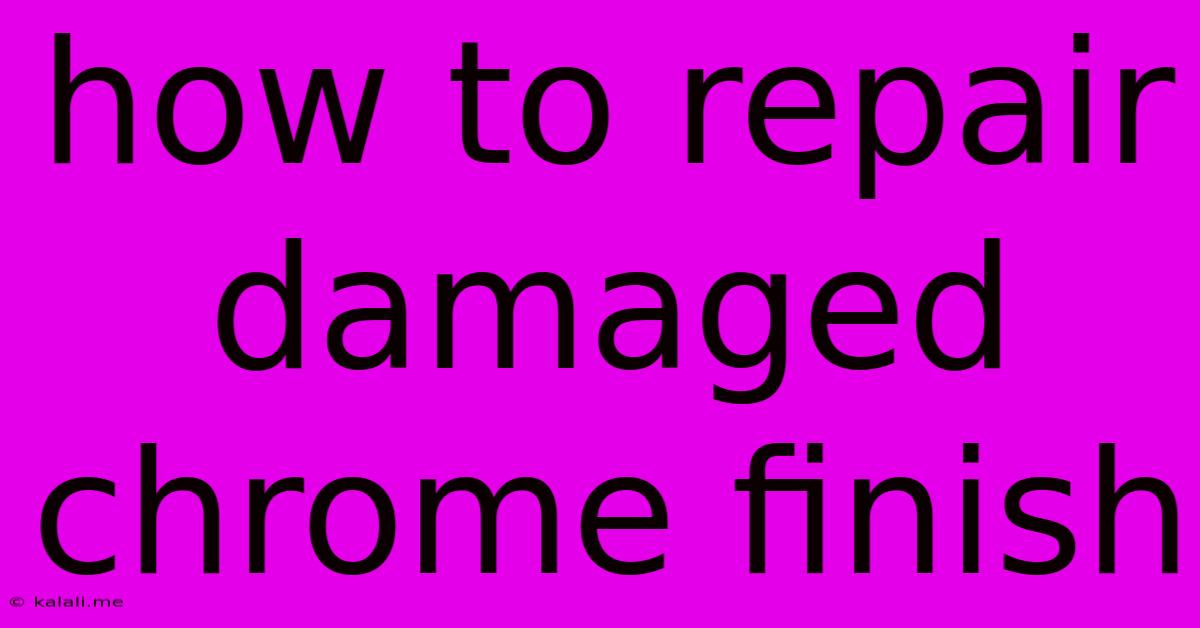How To Repair Damaged Chrome Finish
Kalali
May 22, 2025 · 3 min read

Table of Contents
How to Repair Damaged Chrome Finish: A Comprehensive Guide
Chrome's lustrous sheen adds a touch of elegance and modernity to any surface, but its gleaming perfection is susceptible to scratches, pitting, and discoloration. This guide provides practical solutions for repairing various types of chrome damage, restoring its original shine, and extending its lifespan. Whether it's a minor scratch on your car bumper or a significant dent on a piece of furniture, we'll cover the methods and materials needed for effective chrome repair.
Assessing the Damage: Understanding the Extent of the Problem
Before you begin any repair, it's crucial to assess the extent of the damage. Minor scratches and blemishes can often be tackled with simple polishing techniques, while more severe damage may require more intensive methods, potentially including professional intervention.
- Surface Scratches: These are typically superficial and only affect the top layer of the chrome plating.
- Deep Scratches: These penetrate deeper into the plating, potentially exposing the underlying metal.
- Pitting and Corrosion: This involves significant damage, often due to rust or chemical reactions.
- Large Dents: These require careful straightening before any polishing or refinishing can take place.
Repairing Minor Scratches and Blemishes: DIY Solutions
For minor scratches and blemishes, you can often achieve satisfactory results with DIY methods. These techniques are cost-effective and readily achievable at home.
Materials You'll Need:
- Chrome Polish: Choose a high-quality chrome polish specifically designed for automotive or metal applications. Look for polishes containing fine abrasives.
- Microfiber Cloths: These soft cloths prevent scratching and leave a streak-free finish.
- Applicator Pad (optional): An applicator pad can provide more controlled application of the polish.
Steps:
- Clean the Surface: Thoroughly clean the chrome surface with a mild soap and water solution, ensuring all dirt and debris are removed. Dry completely with a clean microfiber cloth.
- Apply the Polish: Apply a small amount of chrome polish to the affected area, using a circular motion with a microfiber cloth or applicator pad.
- Buff and Polish: Gently buff the area until the scratches are less noticeable or disappear. Use light pressure to avoid causing further damage.
- Rinse and Dry: Rinse the area with clean water and dry thoroughly with a clean microfiber cloth.
Addressing Deeper Scratches and More Severe Damage
Deeper scratches and more extensive damage require a more involved approach. These techniques often involve more specialized materials and potentially require more time and patience.
Techniques for Deeper Scratches:
- Wet Sanding: For deeper scratches, carefully wet sand the area using progressively finer grit sandpaper (starting with a higher grit like 2000 and moving to 3000 or higher). This helps to level the surface. Follow this with polishing.
- Chrome Touch-Up Pen: For very small chips or pits, a chrome touch-up pen can provide a temporary solution. However, be aware that these may not always perfectly match the existing chrome.
Severe Damage:
For severe pitting, corrosion, or large dents, professional help may be necessary. A professional chrome plater can replate the damaged area, restoring the chrome's original appearance. This is generally the most effective solution for extensive damage, though it can be a more costly option.
Maintaining Your Chrome Finish: Prevention is Key
Regular maintenance is crucial for preventing future damage and extending the life of your chrome finishes.
- Regular Cleaning: Regularly clean your chrome surfaces with a mild soap and water solution to remove dirt and grime.
- Avoid Harsh Chemicals: Avoid using abrasive cleaners or harsh chemicals that can damage the chrome plating.
- Protective Coatings: Consider applying a protective coating, such as a sealant or wax, to help shield the chrome from scratches and environmental damage.
By following these steps and employing the appropriate techniques, you can effectively repair damaged chrome finishes and restore their original luster. Remember to choose the right method based on the severity of the damage and take your time to achieve the best possible results. Prevention through proper care and maintenance is also essential in preserving the beauty and longevity of your chrome surfaces.
Latest Posts
Latest Posts
-
When A Force Causes An Object To Move What Happens
May 22, 2025
-
How To Fix Rusted Wheel Arches
May 22, 2025
-
I Found My Passport After Reporting It Lost
May 22, 2025
-
Water Not Coming Out Of Shower Head
May 22, 2025
-
Smoke Detector Chirping After New Battery
May 22, 2025
Related Post
Thank you for visiting our website which covers about How To Repair Damaged Chrome Finish . We hope the information provided has been useful to you. Feel free to contact us if you have any questions or need further assistance. See you next time and don't miss to bookmark.